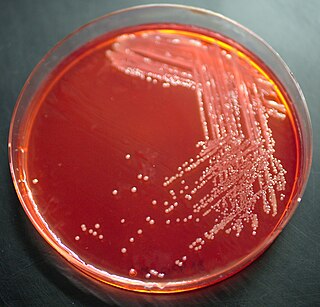
Pseudomonadota is a major phylum of Gram-negative bacteria. The renaming of several prokaryote phyla in 2021, including Pseudomonadota, remains controversial among microbiologists, many of whom continue to use the earlier name Proteobacteria, of long standing in the literature. The phylum Proteobacteria includes a wide variety of pathogenic genera, such as Escherichia, Salmonella, Vibrio, Yersinia, Legionella, and many others. Others are free-living (non-parasitic) and include many of the bacteria responsible for nitrogen fixation.

Yersinia pestis is a gram-negative, non-motile, coccobacillus bacterium without spores that is related to both Yersinia enterocolitica and Yersinia pseudotuberculosis, the pathogen from which Y. pestis evolved and responsible for the Far East scarlet-like fever. It is a facultative anaerobic organism that can infect humans via the Oriental rat flea. It causes the disease plague, which caused the Plague of Justinian and the Black Death, the deadliest pandemic in recorded history. Plague takes three main forms: pneumonic, septicemic, and bubonic. Yersinia pestis is a parasite of its host, the rat flea, which is also a parasite of rats, hence Y. pestis is a hyperparasite.

Yersinia is a genus of bacteria in the family Yersiniaceae. Yersinia species are Gram-negative, coccobacilli bacteria, a few micrometers long and fractions of a micrometer in diameter, and are facultative anaerobes. Some members of Yersinia are pathogenic in humans; in particular, Y. pestis is the causative agent of the plague. Rodents are the natural reservoirs of Yersinia; less frequently, other mammals serve as the host. Infection may occur either through blood or in an alimentary fashion, occasionally via consumption of food products contaminated with infected urine or feces.

Yersinia enterocolitica is a Gram-negative, rod-shaped bacterium, belonging to the family Yersiniaceae. It is motile at temperatures of 22–29°C (72–84°F), but becomes nonmotile at normal human body temperature. Y. enterocolitica infection causes the disease yersiniosis, which is an animal-borne disease occurring in humans, as well as in a wide array of animals such as cattle, deer, pigs, and birds. Many of these animals recover from the disease and become carriers; these are potential sources of contagion despite showing no signs of disease. The bacterium infects the host by sticking to its cells using trimeric autotransporter adhesins.

Yersiniosis is an infectious disease of the gastrointestinal tract caused by bacteria of the genus Yersinia other than Y. pestis. Most cases of yersiniosis in humans are caused by Y. enterocolitica, with a small minority being caused by Y. pseudotuberculosis. Rarely, other species of the genus can cause yersiniosis.

Yersinia pseudotuberculosis is a Gram-negative bacterium that causes Far East scarlet-like fever in humans, who occasionally get infected zoonotically, most often through the food-borne route. Animals are also infected by Y. pseudotuberculosis. The bacterium is urease positive.

The micF RNA is a non-coding RNA stress response gene found in Escherichia coli and related bacteria that post-transcriptionally controls expression of the outer membrane porin gene ompF. The micF gene encodes a non-translated 93 nucleotide antisense RNA that binds its target ompF mRNA and regulates ompF expression by inhibiting translation and inducing degradation of the message. In addition, other factors, such as the RNA chaperone protein StpA also play a role in this regulatory system. The expression of micF is controlled by both environmental and internal stress factors. Four transcriptional regulators are known to bind the micF promoter region and activate micF expression.

Swarming motility is a rapid and coordinated translocation of a bacterial population across solid or semi-solid surfaces, and is an example of bacterial multicellularity and swarm behaviour. Swarming motility was first reported by Jorgen Henrichsen and has been mostly studied in genus Serratia, Salmonella, Aeromonas, Bacillus, Yersinia, Pseudomonas, Proteus, Vibrio and Escherichia.
Yersinia frederiksenii is a Gram-negative species of bacteria. It uses rhamnose and sucrose. Its type strain is strain 6175. In humans, it can cause gastrointestinal infections, while it has also been found in fish.
Yersinia kristensenii is a species of bacteria. It is Gram-negative and its type strain is 105. It is potentially infectious to mice. It secretes a bacteriocin that targets related species.
Yersinia intermedia is a Gram-negative species of bacteria which uses rhamnose, melibiose, and raffinose. Its type strain is strain 3953. It has been found in fish, and contains several biotypes. It is not considered of clinical relevance, being isolated from humans in a routine manner.
Pasteurella lymphangitidis is a bacterium; it causes bovine lymphangitis. Its reclassification to Yersinia has been proposed, given it poses a 99% sequence similarity to both Yersinia pseudotuberculosis and Yersinia pestis.
Yersinia mollaretii is a Gram-negative species of bacteria. The species is named after Henri Mollaret, the former head of the National Yersinia Center at Institut Pasteur.
Yersinia bercovieri is a Gram-negative species of enteric bacteria.

The Yersiniaceae are a family of Gram-negative bacteria that includes some familiar pathogens. For example, the type genus Yersinia includes Yersinia pestis, the causative agent of plague. This family is a member of the order Enterobacterales in the class Gammaproteobacteria of the phylum Pseudomonadota.

Yersinia hibernica is a species of Yersinia that was originally isolated in a pig-production environment. The type strain is CFS1934. This species has previously been misidentified as Yersinia enterocolitica and Yersinia kristensenii but it may be distinguished biochemically by lack of sucrose utilization. In addition to pig related environments, Y. hibernica has also been isolated from the feces of Rattus norvegicus and Hydrochoerus hydrochaeris.
Yersinia aleksiciae is a Gram-negative bacteria that is commonly isolated from the feces of warm-blooded animals such as humans, reindeers, and pigs. The type strain is Y159.
Yersinia wautersii is a species of Gram-negative bacteria that was originally called the Korean Group of the Yersinia pseudotuberculosis complex. The type strain is 12-219N1.
Yersinia pekkanenii is a Gram-negative species of Yersinia that has been isolated from water, soil, and lettuce samples. The type strain is ÅYV7.1KOH2.
Yersinia similis is a Gram-negative bacteria species of Yersinia that resembles Yersinia pseudotuberculosis phenotypically but differs on the basis of 16S ribosomal RNA sequences. The type strain Y228 was originally isolated from a rabbit in Germany.







